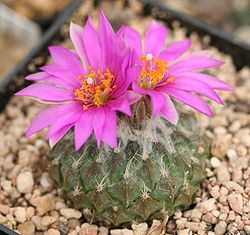Top Qs
Timeline
Chat
Perspective
Pelecyphora
Genus of cacti From Wikipedia, the free encyclopedia
Remove ads
Pelecyphora, pincushion cactus or foxtail cactus[1] is a genus of cacti, comprising 20 species. They originate from Mexico and the United States.[2][3]
Common species include the Missouri foxtail cactus P. missouriensis,[4] widespread in grassland and forest west of the Mississippi, and the spinystar P. vivipara,[5] distributed across the US and into Canada, first described by Nuttall in 1813.
Remove ads
Description
Pelecyphores are spherical to club-shaped stem succulents up to 6 cm (2.4 in) in diameter and gray-green in color. They branch only sparsely and only at an older age. The areoles standing on the longitudinally or transversely flattened warts have thorns in a pectinate (comb-shaped) arrangement. As we age, the thorns, then the areoles and finally the warts fall off. Between the warts, the plant bodies are initially dense and short-haired, so that the apexes are hidden.
The flowers arise individually from short furrows on the upper surfaces of the youngest areoles. They are bright purple and about 3 cm (1.2 in) long. The greenish fruits that form after the flowers are fertilized dry out when ripe and release the black seeds into the crown wool, from which they are only washed out (in nature) after a long time.[6]
Remove ads
Taxonomy
Summarize
Perspective
Species accepted As of November 2023[update] by Plants of the World Online with sections from Nigel Paul Taylor from 1986:[7][8]
Remove ads
Synonymy
At genus level
At species level
The following are synonyms of species now placed outside of Pelecyphora:
- Pelecyphora aselliformis var. pectinata (= Mammillaria pectinifera)
- Pelecyphora pectinata (= Mammillaria pectinifera)
- Pelecyphora pseudopectinata (= Turbinicarpus pseudopectinatus)
- Pelecyphora valdeziana (= Turbinicarpus valdezianus)
- Pelecyphora plumosa (= Turbinicarpus valdezianus)
- Pelecyphora pulcherrima (= Turbinicarpus pseudopectinatus)
Psychoactivity
- Pelecyphora aselliformis: Mescaline (Less than 0.00002% in dry weight) Neal et al. 1972
Conservation status
Both P. aselliformis and P. strobiliformis are classified as being of Least Concern on the IUCN Red List, however both species are contained in Appendix 1 of CITES species (Convention on International Trade in Endangered Species) as at June 2013.
References
External links
Wikiwand - on
Seamless Wikipedia browsing. On steroids.
Remove ads

















